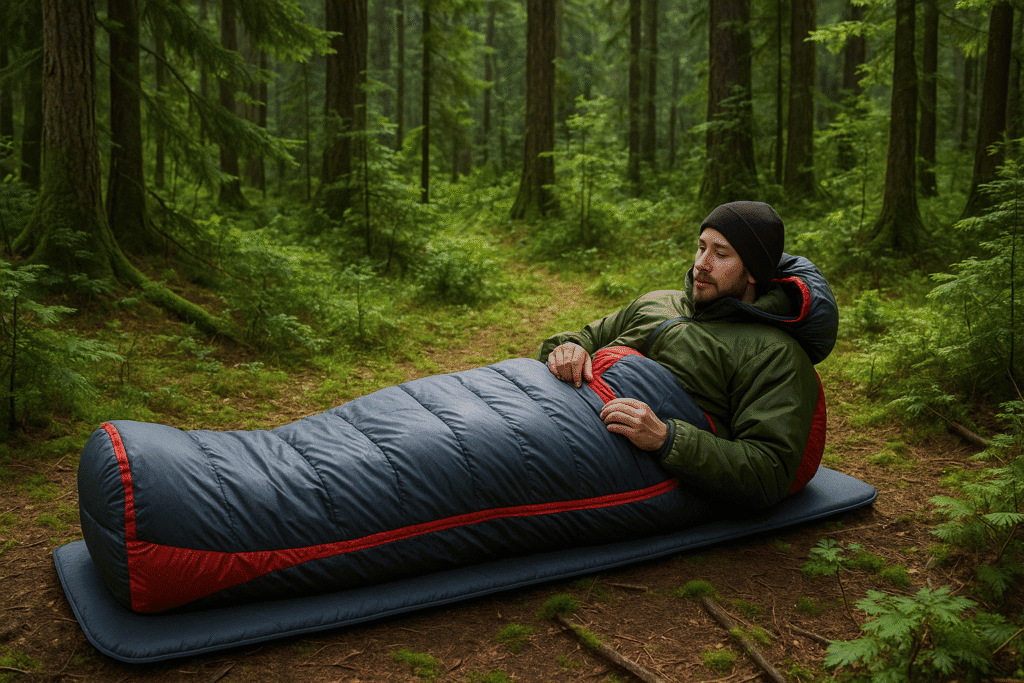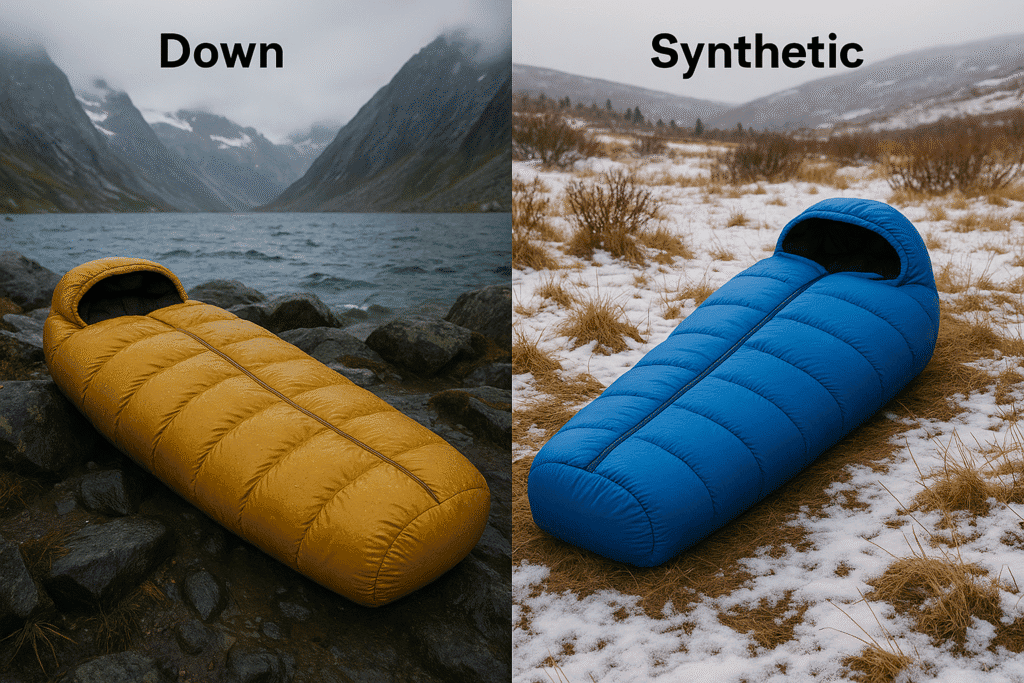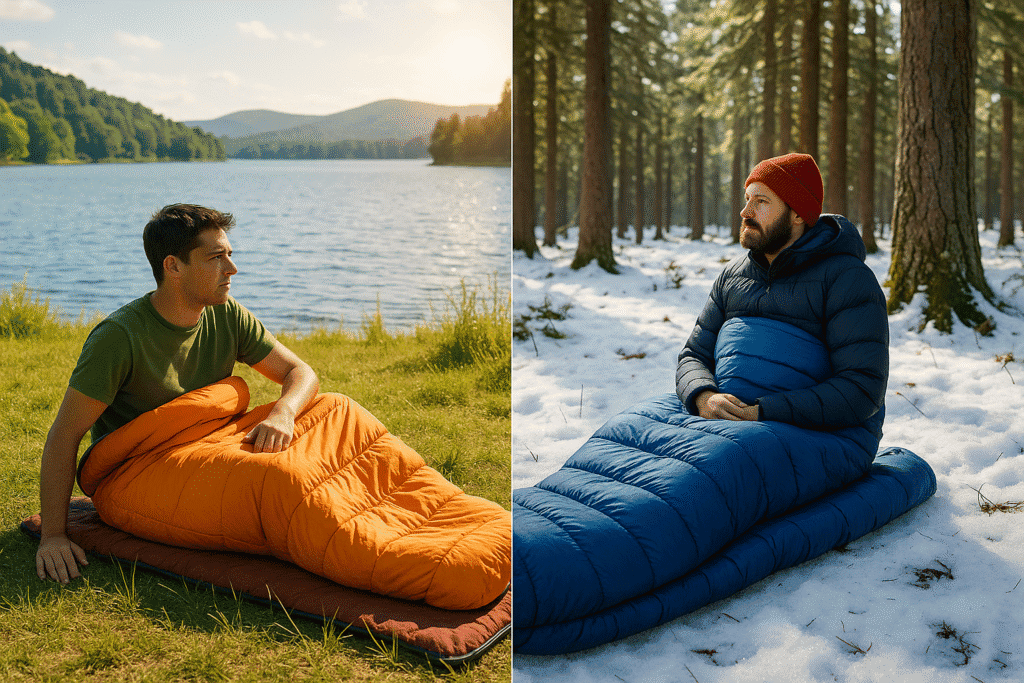はじめに
寝袋の温度表示を確認したにもかかわらず、寝袋の中で震えて目が覚めたことはないだろうか?それはあなただけではありません。3シーズン用スリーピングバッグの真実は、実際の性能はラベルに印刷されているものより、インサレーションの種類や気象条件によって大きく左右されるということです。
で ケリーランド・アウトドアーズ私たちは、湿度の高い南部の森林から爽やかな北部の秋まで、中国の多様な気候にわたって何百ものスリーピングバッグをテストしてきました。重要な教訓は?ダウンと化繊の中綿には、それぞれ適した季節があり、その季節にはどちらが優れているかということだ。このガイドでは、春のにわか雨、夏の夜、そして秋の予測不可能な冷え込みにどのインサレーションが本当に適しているのかを、スペック別にご紹介します。
3シーズン用スリーピングバッグの基礎知識
「3シーズン用スリーピングバッグは、春、夏、秋のキャンプ用にデザインされており、30°Fから50°Fの範囲の気温で多用途性と快適性を提供する。
に関しては キャンプ用品3シーズン用スリーピングバッグは、アウトドア愛好家の必需品です。これらのスリーピングバッグは春、夏、秋の様々なコンディションに対応できるように作られており、冬以外のほとんどのキャンプに理想的です。山をバックパッキングするにしても、湖畔でキャンプを張るにしても、3シーズン用スリーピングバッグの特徴を理解することで、快適に過ごすことができます。
3シーズン用スリーピングバッグの定義とは?
3シーズン用スリーピングバッグは、通常30°F~50°Fの中程度の気温で十分な性能を発揮するようにデザインされています。極端な寒さに対応するために断熱材を多用した冬用スリーピングバッグとは異なり、保温性と通気性のバランスが取れたバッグです。多くの場合、ドラフトカラーやジッパーベントなど調節可能なベンチレーションを備えており、コンディションの変化に応じて体温調節ができるようになっています。
春・夏・秋のカバー範囲の説明
3シーズン用スリーピングバッグの大きな強みは、その適応性にある。夜が冷え込む春と秋は、断熱材が体を温めます。夏には、軽量素材と通気性オプションがオーバーヒートを防ぎます。この多用途性は、さまざまな気候を探検するキャンパーにとって実用的な選択肢となる。
ダウンと合成断熱材の比較
3シーズン用スリーピングバッグには、主にダウンとシンセティックという2種類のインサレーションが使用されている。 ダウン寝袋 は軽量で圧縮性が高く、優れた保温性を発揮する。しかし、濡れると保温性が低下する。一方、合成繊維のバッグは湿っていても保温性があり、価格も手頃です。ケリーランド・アウトドアーズではこの2つのバッグを専門に取り扱っており、お客様のニーズに合わせてカスタマイズ可能なオプションを提供しています。
実際の使用における温度定格
メーカー各社は購入者の目安となるような温度を提示しているが、実際のコンディションはさまざまだ。30°F用のバッグでも、適切なレイヤリングをすれば35°Fでも快適に感じられるかもしれない。バッグを選ぶ際は、湿度や風、個人の睡眠習慣などを常に考慮してください。バックパッキングには、軽量なダウンの3シーズン用スリーピングバッグがパッキングしやすいという点で好まれます。
なぜ多用途性が重要なのか
キャンパーは、特に季節の変わり目には予測不可能な天候に直面する。多用途に使えるスリーピングバッグは、こうした天候の変化に対応できるため、複数のバッグを用意する必要がありません。調節可能なフード、ジッパーによる隙間風、湿気に強い素材など、季節を問わず性能を発揮する機能を探してみましょう。
3シーズン用スリーピングバッグの性能比較
| 特徴 | ダウン・インサレーション | 合成断熱材 | 理想的な使用例 | メンテナンスのヒント |
|---|---|---|---|---|
| 保温重量比 | 高い | 中程度 | バックパッキング、乾燥した気候 | 湿気を避け、圧縮せずに保管する |
| ウェット時の性能 | 貧しい | グッド | 湿度が高い、または雨が降っている | 洗濯機で洗える。 |
| 梱包性 | 素晴らしい | フェア | 超軽量バックパッキング | 圧縮袋を使用する |
| 耐久性 | お手入れ次第で長持ち | 摩耗に強い | 使用頻度 | メーカーのガイドラインに従う |
| コスト | より高い | より手頃な価格 | 予算重視のバイヤー | ニーズに基づいた投資 |
3シーズン用スリーピングバッグの選択は、あなたのキャンプスタイル、予算、そして想定されるコンディションによって異なります。軽量でラグジュアリーなダウンをお好みの方にも、信頼性の高いシンセティック素材をお好みの方にも、ケリーランド・アウトドアーズはお客様のニーズに合った選択肢を提供します。ケリーランド・アウトドアーズでは、お客様のニーズに合ったスリーピングバッグをお選びいただけます。

ダウン vs 合成素材:パフォーマンス対決
「3シーズン用スリーピングバッグのインサレーションをダウンと化繊のどちらかから選ぶ場合は、保温性対重量比、耐湿性、パッキングのしやすさなどを考慮し、自分のキャンプ・ニーズに合ったものを選ぶこと。
3シーズン用スリーピングバッグのインサレーションをダウンにするか化繊にするかは、キャンパーが直面する最も重要な決断のひとつだ。どちらの素材にも異なる利点があり、それぞれ異なるコンディションに適しています。これらの違いを理解することで、あなたの冒険に適したスリーピングバッグを選ぶことができます。
保温重量比:ダウンがドライコンディションでリードする理由
一般的にガチョウやアヒルの羽毛から作られるダウンは、重量の割に保温性に優れています。高品質なダウンスリーピングバッグは軽量でありながら優れた保温性を発揮します。ダウンのロフト性は小さなエアポケットを作り出し、熱を効率的に閉じ込めるので、軽量化が最も重要な寒冷で乾燥したコンディションに理想的です。
耐湿性:合成繊維の利点
合成繊維のインサレーションは濡れても保温性を維持するため、湿気の多い環境や雨の多い環境では重要な要素となります。ダウンは湿ると保温性をほとんど失いますが、合成繊維は保温性を維持します。そのため、雨に濡れる可能性のある環境でのキャンプや、湿度の高い沿岸部でのキャンプには化繊の3シーズン用スリーピングバッグが適しています。
梱包性の比較
ダウンスリーピングバッグは化繊のものよりかなり小さく圧縮されるため、バックパックのスペースを大幅に節約できます。しかし、化繊のスリーピングバッグの方が圧縮後のロフトが回復することが多く、保管にそれほど注意を払う必要はありません。ケリーランドが中国の様々な気候で行ったテストによると、ダウンの方が小さくパッキングできる一方、化繊の方がパッキングと開梱を繰り返しても安定した性能を維持できることがわかりました。
耐久性と寿命
適切な手入れをすれば、ダウンスリーピングバッグは何十年も使うことができます。ダウンはよりメンテナンスが必要で、圧縮せずに保管し、乾燥させておく必要があります。合成繊維のスリーピングバッグはお手入れが簡単なので、カジュアルなキャンパーやメンテナンスの手間を省きたい人に向いています。
断熱性能の比較
| 特徴 | ダウン・インサレーション | 合成断熱材 | 試験方法 | 最適 |
|---|---|---|---|---|
| オンスあたりの暖かさ | エクセレント(フィルパワー800以上) | 良好(繊維の種類によって異なる) | 空調管理されたチャンバー | 超軽量バックパッキング |
| ウェット・パフォーマンス | 不良(90%絶縁を失う) | 良好(80%の暖かさを保つ) | 模擬降雨テスト | 湿度が高い/雨が多い |
| 圧縮性 | スーペリア(パックが非常に小さい) | 中程度(よりかさばる) | 標準圧縮試験 | 空間を意識した梱包 |
| 耐久性 | お手入れ次第で長持ち | 一般的な寿命は5~7年 | 加速摩耗試験 | 長期投資 |
| メンテナンス | 慎重な保管が必要 | 洗濯機で洗える | 実使用トラッキング | 低メンテナンスユーザー |
3シーズン用スリーピングバッグのインサレーションをダウンとシンセティックから選ぶ際は、キャンプをする場所と頻度を考慮してください。ケリーランドのスリーピングバッグは、湿度の高い南部から乾燥した北西部まで、中国の様々な気候に対応した厳格なテスト・プロトコルを実施し、実環境で期待される性能を満たしています。軽量化を優先するにしても、耐候性を優先するにしても、これらの重要な違いを理解することで、あなたのアウトドア・アドベンチャーに適した選択ができるようになります。

季節適応ガイド
「3シーズン用スリーピングバッグに適したインサレーションを選ぶには、季節のコンディションに左右される。
適切な3シーズン用スリーピングバッグを選ぶには、春、夏、秋のコンディションで異なるインサレーションがどのように機能するかを理解する必要があります。それぞれの季節には、ダウンや合成繊維のインサレーションを使用することで対応できるユニークな課題があります。ケリーランドのコンバーチブル・オプションは、変わりやすい天候に直面するキャンパーに柔軟なソリューションを提供します。
春のキャンプ:シンセティックの耐候性
春の予測不可能な天候は、化繊のインサレーションを理想的なものにする。突然のにわか雨や朝露がギアを濡らす恐れがあっても、化繊素材ならダウンよりも保温性が高い。湿気に強いため、コンディションが変化しても快適さを保つことができ、シーズン初めのアドベンチャーに最適だ。
夏の夜:ダウンのコンパクトコンフォート
バックパックのスペースが貴重な暖かい夏の夜には、ダウンスリーピングバッグが輝きます。その優れた圧縮性はバックパックの貴重なスペースを節約すると同時に、涼しい山の夜には十分な暖かさを提供します。高品質なダウンは軽量なので、1オンス1オンスが重要な夏のバックパッキングに最適です。
秋の冒険シンセティックの湿った天候のエッジ
秋になって気温が下がり湿度が上がっても、合成繊維のインサレーションはその優位性を維持します。朝の霜や湿った状況でも、スリーピングバッグの性能を損なうことはありません。雨に濡れる可能性のある環境での秋のキャンプには、合成繊維製の3シーズン用スリーピングバッグが湿気に関係なく信頼できる暖かさを提供します。
移行期間のソリューション
季節の移り変わりの激しい旅行には、ケリーランドのミックスフィル・オプションが完璧なバランスを提供します。これらの革新的なデザインは、乾燥したエリアではダウンを、湿気のたまりやすいエリアでは合成繊維のインサレーションを組み合わせています。このハイブリッド・アプローチは、旅を通して変化するコンディションにシームレスに適応し、両素材の利点を提供します。
断熱性能ガイド
| シーズン | 推奨断熱材 | 主な利点 | 温度範囲 | ケリーランド・ソリューション |
|---|---|---|---|---|
| 春 | 合成 | 耐湿性 | 40-60°F | ウェザーシールドシリーズ |
| 夏 | ダウン | 軽量パッキング性 | 50-70°F | クラウドライト・コレクション |
| 秋 | 合成 | 耐湿性 | 30-50°F | オータムトレイルライン |
| トランジショナル | ミックスフィル | 適応可能なパフォーマンス | 可変 | アダプタコアシステム |
| 可変 | コンバーチブル | モジュール式の柔軟性 | カスタマイズ可能 | シーズンフレックス・オプション |
このような季節の違いを理解することで、アドベンチャーに適したスリーピングバッグを選ぶことができます。ケリーランドは伝統的なスリーピングバッグと革新的なハイブリッド・スリーピングバッグの両方を製造しており、どのような季節の課題にも完璧なソリューションを提供します。中国の多様な気候に対応するための厳しいテストは、あなたが最も必要とするときに、実際の性能を保証します。

バイヤーの意思決定フレームワーク
「ダウンと化繊の3シーズン用スリーピングバッグのどちらを選ぶかは、旅行期間、睡眠習慣、必要な荷物スペース、予算などを考慮する必要がある。
完璧な3シーズン用スリーピングバッグを選ぶには、単に温度評価を比較するだけでは不十分です。賢いバイヤーは複数の要素を考慮し、性能と実用性の理想的なバランスを見つけます。ケリーランドの専門知識は、個人のキャンパーと販売店の両方が、スリーピングバッグの在庫について十分な情報を得た上で決断するのに役立ちます。
旅行期間に関する考慮事項
週末を利用した遠征の場合、シンセティック素材のバッグはメンテナンスが簡単でコストパフォーマンスに優れています。数日間の遠征であれば、ダウンの優れた保温性とパッキングのしやすさが役に立ちます。3シーズン用スリーピングバッグを選ぶ際は、野外で何泊するかを考慮してください。
個人の睡眠習慣
コールドスリーパーは予想気温より10°F低いものを、ウォームスリーパーは軽めのインサレーションを選ぶとよい。ダウンは暑がりな人の体温調節に適しており、合成繊維の安定した保温性は湿気の多い環境での寒がりな人に適している。
パックスペースの制約
スペースの節約を優先するウルトラライト・バックパッカーはダウンの圧縮性を高く評価するだろう。しかし、より大きなパックを使用する方は、耐候性に優れたシンセティック(合成繊維)を好むかもしれません。ケリーランドのB2Bサービスは、このような多様なキャンパーニーズに対応するため、小売店がバランスの取れた在庫を仕入れるお手伝いをします。
予算要因
ダウンは初期費用は高いが、その耐久性から長期的には経済的であることが多い。合成繊維のバッグは、たまにしかキャンプをしない人にとっては非常にお得です。キャンプをする頻度や予算などを考慮した上で購入しましょう。
寝袋決定マトリックス
| ファクター | ダウン・アドバンテージ | シンセティック・アドバンテージ | 主な検討事項 | ケリーランド・ソリューション |
|---|---|---|---|---|
| 旅行期間 | 複数日の旅行 | 週末キャンプ | 使用頻度 | 遠征ラインと週末ライン |
| スリープ・スタイル | 温度調節 | 安定した暖かさ | 個人的な快適さ | サーモ・アダプト・テクノロジー |
| パックサイズ | 超軽量パッキング | 耐候性 | スペース対コンディション | コンパクト vs シールド・シリーズ |
| 予算 | 長期的価値 | 手頃なエントリー | 使用1回あたりのコスト | バリューとプレミアムの比較 |
| メンテナンス | 適切なケア | 簡単なクリーニング | ユーザーのコミットメント | 介護プログラムガイド |
この決定フレームワークは、キャンパーがダウンと化繊の選択肢を選ぶ際に、具体的なニーズを評価するのに役立ちます。ケリーランドの包括的なB2Bサービスは、ウルトラライト愛好家からファミリーキャンパーまで、小売店がそれぞれの顧客層に適した製品を提供できるようサポートします。これらの要素を考慮することで、あなたのアウトドアライフスタイルに完璧にマッチする3シーズン用スリーピングバッグを見つけることができます。

ケアと最適化戦略
「適切なメンテナンスは3シーズン用スリーピングバッグの寿命を数年延ばすことができる。
3シーズン用スリーピングバッグの性能を最大限に引き出し、長持ちさせるには、それぞれのインサレーションタイプに特有のお手入れの必要性を理解する必要があります。ケリーランドのアフターセールス・サポートと交換用パーツは、数え切れないほどの冒険のためにあなたの投資を維持できることを保証します。
適切な保管方法
ダウンスリーピングバッグはロフトを維持するため、常に通気性の良いコットンサックに圧縮せずに収納すること。シンセティック素材のバッグの方が収納には適していますが、緩く収納した方が良いことに変わりはありません。ケリーランドでは 保存袋 すべてのスリーピングバッグは、顧客の投資を保護するためのものである。
クリーニング・プロトコル
合成繊維のバッグは通常洗濯機で洗えますが、ダウンはダウン専用の洗剤と丁寧な乾燥が必要です。ケリーランドでは、各製品に詳細なクリーニング方法を記載しており、プレミアム・ダウン・モデルについては、専門家によるクリーニング・サービスも提供しています。
フィールド修理
どちらのインサレーション・タイプも、小さな破れは避けられません。ケリーランドのスリーピングバッグにはリペアキットが付属しており、合成素材には粘着パッチ、羽毛入りモデルにはダウンプルーフテープが付属している。カスタマーサービス・チームが修理の手順を教えてくれる。
パフォーマンス向上
ライナーを追加することで、バッグの温度範囲を広げ、クリーニングの頻度を減らすことができます。ケリーランドでは、スリーピングバッグのデザインにぴったりフィットするカスタムフィットライナーを提供しています。
メンテナンス比較表
| ケアの側面 | ダウン要件 | 合成の利点 | ケリーランド・サポート | 頻度 |
|---|---|---|---|---|
| ストレージ | 吊り下げ/非圧縮 | より柔軟なオプション | 収納袋付き | 連続 |
| クリーニング | 専門プロセス | 洗濯機で洗える | 詳細ガイド | 季節限定 |
| 修理 | ダウン専用パッチ | 標準修理 | 付属修理キット | 必要に応じて |
| リフレッシュ | ロフトの修復 | ウォッシュは活性化する | プロフェッショナル・サービス | 年間 |
| アクセサリー | 専用ライナー | ユニバーサル・オプション | カスタムソリューション | オプション |
これらのお手入れ方法を実践することで、あなたの3シーズン用スリーピングバッグは最高のパフォーマンスを発揮することでしょう。ケリーランドはアフターサービスにも力を入れており、交換部品やクリーニングサービス、専門家によるアドバイスなど、常に最高のコンディションを保つためのサービスを提供しています。
結論
湿度の高い森から爽やかな山の空気まで、あらゆる場所でスリーピングバッグをテストしてきた私が学んだことは、「最高」のインサレーションは存在しないということだ。ダウンはドライで軽量なトリップに適した素材であり、合成繊維はジメジメした天候でも暖かさを保ってくれる。
ケリーランドでは、その両方を使ってキャンプを楽しむ人たちを見てきました。夏の日の出でも秋の紅葉でも、寝袋は妥協の産物ではなく、あなたの道具の一部であるべきなのです。
そこで自問する:次の焚き火はどこでする?その答えが、あなたにぴったりのバッグと星空の下での正しい夜を指し示してくれるはずだ。
よくあるご質問
-
Q1: 3シーズン用スリーピングバッグとは何ですか?
A1: 3シーズン用スリーピングバッグは、春、夏、秋を通してより寒いコンディションで使用するためにデザインされたもので、最低気温は約20°F(-5°C)まで対応可能です。保温性、重さ、かさばりのバランスがよく、様々なキャンプシーンに対応します。
-
Q2: 3シーズン用スリーピングバッグの選び方は?
A2: 3シーズン用スリーピングバッグを選ぶ際は、気温(通常15°F~20°F)、インサレーションタイプ(ダウンか化繊か)、重量、サイズなどを考慮しましょう。また、ドラフトカラーやジッパーなど、快適性を高める付加的な機能を探すことも大切です。
-
Q3: 3シーズン用スリーピングバッグは冬でも使えますか?
A3: 3シーズン用スリーピングバッグは晩秋や春先の寒さには対応できるが、極寒の冬には十分な保温性を発揮できないかもしれない。4シーズン用を選ぼう スリーピングバッグ 氷点下だ。
-
Q4: ダウンと化繊の寝袋の違いは何ですか?
A4: ダウンスリーピングバッグは軽量で圧縮性が高く、保温性に優れていますが、濡れると保温性が低下します。合成繊維のスリーピングバッグはかさばらず、価格も安く、湿った状態でもある程度の保温性を保つため、濡れたコンディションに適している。
-
Q5: 3シーズン用スリーピングバッグは2シーズン用より暖かいですか?
A5: そう、3シーズン用スリーピングバッグは一般的に2シーズン用よりも暖かく、より寒い夜でも快適に過ごせるよう保温性が高く設計されている。
-
Q6: 3シーズン用スリーピングバッグの対応温度範囲は?
A6: 3シーズン用スリーピングバッグは一般的に-6°C~0°C(20°F~32°F)の気温で使用できるため、春、夏、初秋のキャンプに最適です。
-
Q7: バックパッキング用の3シーズン用スリーピングバッグのパッキング方法は?
A7: バックパッキング用の3シーズン用スリーピングバッグをパッキングする際は、収納スペースを減らすためにスタッフサックに圧縮し、収納前に乾いていることを確認してください。バックパックの上部や外側のポケットに入れれば、キャンプを設営した後でも簡単に取り出せます。
-
Q8: 3シーズン用スリーピングバッグにはどんな機能を求めるべきですか?
A8: 断熱性の高いフード、ドラフトカラー、防水素材、体温調節が可能なジッパーなどを探す。さらに、バックパッキングをする場合は、バッグの重量とパッキングのしやすさも考慮しよう。
